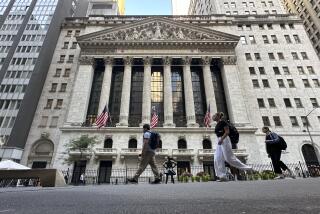This was Wall Street’s worst quarter in two years

- Share via
A late burst of selling left stocks broadly lower on Wall Street on Thursday, as the market closed out its worst quarter since the pandemic broke out two years ago.
Despite a 3.6% gain for March, a dismal January and February left U.S. indexes lower for the year to date. The Standard & Poor’s 500 ended the day down 1.6%, bringing its loss since the beginning of the year to 4.9%.
The Dow Jones industrial average fell 1.6%, while the Nasdaq composite fell 1.5%. Both indexes also notched gains for March, thanks largely to a market rally in the two weeks heading into this week.
Oil prices fell as President Biden ordered the release of up to 1 million barrels of oil per day from the nation’s strategic petroleum reserve. The move to pump more oil into the market is part of an effort to control energy prices, which are up nearly 40% globally this year.
Buying a home for the first time is one of life’s sweet milestones.
Wall Street’s downbeat finish to March comes as investors try to navigate the market risks amid surging inflation, geopolitical instability and uncertainty over how aggressively the Federal Reserve will raise interest rates to quash inflation.
“Yesterday’s weakness and some weakness today may be in response to sentiment that’s a little more cautious given the recent strength in the last two weeks and the ongoing uncertainty related to inflation and earnings,” said Terry Sandven, chief equity strategist at U.S. Bank Wealth Management.
The S&P 500 fell 72.04 points to 4,530.41. The Dow fell 550.46 points to 34,678.35, and the Nasdaq slid 221.76 points to 14,220.52.
Smaller-company stocks also fell. The Russell 2000 index dropped 20.94 points, or 1%, to 2,070.12.
About 85% of stocks in the benchmark S&P 500 fell. Much of the movement seemed like a “consolidation” for investors, said Scott Wren, senior global market strategist at Wells Fargo Investment Institute.
“This is a little give back today just from the big run that we had, but we’re hanging in here pretty well,” Wren said. Major indexes fell on Wednesday to end a four-day winning streak.
A new study shows just how badly Sweden fared in the pandemic.
Technology and communications stocks were among the biggest weights on the market. Many of the companies in those sectors have pricey stock values that tend to give the broader market a more forceful push either up or down. Chipmaker Intel fell 3.6%, while Facebook parent Meta Platforms slid 2.4%.
Banks also fell along with bond yields. A decline in yields forces interest rates on loans lower, making lending less profitable for banks. The yield on the 10-year Treasury slipped to 2.34% from 2.36% late Wednesday. Bank of America fell 4.1%.
U.S. crude oil prices fell 7%; Brent, the international standard, fell 4.9%. The pullback slightly trimmed what have been soaring oil prices amid Russia’s invasion of Ukraine. The conflict has elevated concerns that tightened supplies will only worsen the persistently high inflation that threatens businesses and consumers globally.
An inflation gauge that is closely monitored by the Federal Reserve jumped 6.4% in February compared with a year ago, marking the largest year-over-year rise since January 1982.
Energy prices have been a key factor in pushing inflation higher, and Biden’s plan to release more oil into the system comes as little relief is expected from the oil cartel OPEC. The cartel and its allied oil producers including Russia are sticking to a modest increase in the amount of crude they pump, a step that supports higher prices.
Higher prices for energy, food and most other things have been a key concern of the world’s central banks, which are moving to raise interest rates to help temper the effects. Investors have been trying to measure how the economy and companies will fare amid high inflation, higher interest rates, the war in Ukraine and other factors. That has made for a rocky start to the year.
Investors received a lukewarm update on the job market on Thursday. More Americans applied for unemployment benefits last week, but layoffs remain at historical lows. Wall Street will get a fuller report on Friday when the Labor Department releases employment data for March.
More to Read
Inside the business of entertainment
The Wide Shot brings you news, analysis and insights on everything from streaming wars to production — and what it all means for the future.
You may occasionally receive promotional content from the Los Angeles Times.












